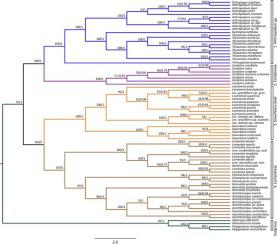当前位置:
X-MOL 学术
›
Mol. Phylogenet. Evol.
›
论文详情
Our official English website, www.x-mol.net, welcomes your feedback! (Note: you will need to create a separate account there.)
Evolution of Lomandroideae: Multiple origins of polyploidy and biome occupancy in Australia.
Molecular Phylogenetics and Evolution ( IF 4.1 ) Pub Date : 2020-04-15 , DOI: 10.1016/j.ympev.2020.106836 Bee F Gunn 1 , Daniel J Murphy 1 , Neville G Walsh 1 , John G Conran 2 , J Chris Pires 3 , Terry D Macfarlane 4 , Joanne L Birch 5
Molecular Phylogenetics and Evolution ( IF 4.1 ) Pub Date : 2020-04-15 , DOI: 10.1016/j.ympev.2020.106836 Bee F Gunn 1 , Daniel J Murphy 1 , Neville G Walsh 1 , John G Conran 2 , J Chris Pires 3 , Terry D Macfarlane 4 , Joanne L Birch 5
Affiliation

|
Asparagaceae: Lomandroideae are a species-rich and economically important subfamily in the monocot order Asparagales, with a center of diversity in Australia. Lomandroideae are ecologically diverse, occupying mesic and arid biomes in Australia possessing an array of key traits, including sexual dimorphism, storage organs and polyploidy potentially adaptive for survival in seasonally arid and fire-dependent habitats. The Lomandroideae phylogeny was reconstructed using maximum likelihood and Bayesian inferences criteria, based on plastome data from genome-skimming to infer generic and specific relationships. A fossil-calibrated chronogram provided a temporal framework for understanding directional and transitions of traits. Ancestral state reconstructions and phylogenetic comparative trait correlations analyses provided insights for evolutionary and ecological drivers associated with Lomandroideae diversification. Lomandroideae diverged from the other Asparagaceae ca 56 Ma and the major lineages diversified since Oligocene-Miocene. The Most Recent Common Ancestor of the clade likely occupied the mesic biome, was hermaphroditic and geophytic. The probability of biome occupancy transition was increased by 1. evolution of polyploidy, and 2. the presence of storage roots. Polyploidy potentially serves as an "enabler" trait, generating novel phenotypes, which may confer tolerance to climatic ranges and soil conditions putatively required for expansion into and occupation of new arid biomes. Storage roots, as a key factor driving biome transitions, may have been associated with fire rather than with aridification events in the Australian flora. This study contributes significantly to our understanding of biome evolution by identifying polyploidy and storage organs as key factors associated with transitions in biome occupancy in this lineage.
中文翻译:

Lomandroideae的演变:多倍体和生物群落在澳大利亚的起源。
芦笋科:Lomandroideae是单子叶植物Asparagales的一个物种丰富且经济上重要的亚科,在澳大利亚具有多样性中心。蓝藻科在生态上是多样的,在澳大利亚占据了中生和干旱的生物群落,具有一系列关键特征,包括性二态性,贮藏器官和多倍体,可能适应季节性干旱和火源栖息地的生存。Lomandroid ae系统发育是使用最大似然和贝叶斯推断标准,基于从基因组撇取的塑性组数据推断出一般和特定关系而重建的。化石校准的计时码表为理解特质的方向和转变提供了一个时间框架。祖先状态重建和系统发育比较性状相关分析为与Lomandroideae多样化相关的进化和生态驱动器提供了见识。Lomandroid eae从另一个约56 Ma的天门冬科开始分化,并且从新渐新世到中新世以来主要的谱系开始多样化。进化枝的最新祖先可能占据了mesic群落,是雌雄同体的和地理上的。通过1.多倍体的进化和2.贮藏根的存在增加了生物群落占有转变的可能性。多倍体潜在地充当“使能者”性状,产生新的表型,这可能赋予对扩展和占领新的干旱生物群落可能需要的气候范围和土壤条件的耐受性。存储根源是推动生物群落过渡的关键因素,可能与火灾有关,而不是与澳大利亚植物区系的干旱化事件有关。这项研究通过将多倍体和贮藏器官鉴定为与该谱系中生物群落占有率过渡相关的关键因素,为我们对生物群落进化的理解做出了重要贡献。
更新日期:2020-04-15
中文翻译:

Lomandroideae的演变:多倍体和生物群落在澳大利亚的起源。
芦笋科:Lomandroideae是单子叶植物Asparagales的一个物种丰富且经济上重要的亚科,在澳大利亚具有多样性中心。蓝藻科在生态上是多样的,在澳大利亚占据了中生和干旱的生物群落,具有一系列关键特征,包括性二态性,贮藏器官和多倍体,可能适应季节性干旱和火源栖息地的生存。Lomandroid ae系统发育是使用最大似然和贝叶斯推断标准,基于从基因组撇取的塑性组数据推断出一般和特定关系而重建的。化石校准的计时码表为理解特质的方向和转变提供了一个时间框架。祖先状态重建和系统发育比较性状相关分析为与Lomandroideae多样化相关的进化和生态驱动器提供了见识。Lomandroid eae从另一个约56 Ma的天门冬科开始分化,并且从新渐新世到中新世以来主要的谱系开始多样化。进化枝的最新祖先可能占据了mesic群落,是雌雄同体的和地理上的。通过1.多倍体的进化和2.贮藏根的存在增加了生物群落占有转变的可能性。多倍体潜在地充当“使能者”性状,产生新的表型,这可能赋予对扩展和占领新的干旱生物群落可能需要的气候范围和土壤条件的耐受性。存储根源是推动生物群落过渡的关键因素,可能与火灾有关,而不是与澳大利亚植物区系的干旱化事件有关。这项研究通过将多倍体和贮藏器官鉴定为与该谱系中生物群落占有率过渡相关的关键因素,为我们对生物群落进化的理解做出了重要贡献。

























 京公网安备 11010802027423号
京公网安备 11010802027423号